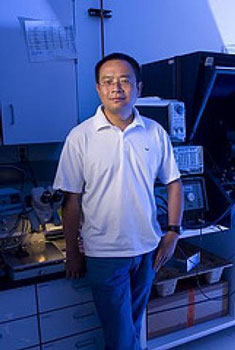| Posted: July 9, 2009 |
First direct measurement of quantum capacitance of graphene |
|
(Nanowerk News) Since its discovery just a few years ago, graphene has climbed to the top of the heap of new super-materials poised to transform the electronics and nanotechnology landscape. As N.J. Tao, a researcher at the Biodesign Institute of Arizona State University explains, this two dimensional honeycomb structure of carbon atoms is exceptionally strong and versatile. Its unusual properties make it ideal for applications that are pushing the existing limits of microchips, chemical sensing instruments, biosensors, ultracapacitance devices, flexible displays and other innovations.
|
|
In the latest issue of Nature Nanotechnology, Tao describes the first direct measurement of a fundamental property of graphene, known as quantum capacitance, using an electrochemical gate method. A better understanding of this crucial variable should prove invaluable to other investigators participating in what amounts to a gold rush of graphene research.
|
 |
| N. J. Tao, director of the Center for Bioelectronics and Biosensors at the Biodesign Institute of Arizona State University, has experimentally measured an important property of graphene -- a two-dimensional crystal lattice with broad potential for electronic applications.
|
|
Graphene displays outstanding electron transport, permitting electricity to flow rapidly and more or less unimpeded through the material. In fact, electrons have been shown to behave as massless particles similar to photons, zipping across a graphene layer without scattering. This property is critical for many device applications and has prompted speculation that graphene could eventually supplant silicon as the substance of choice for computer chips, offering the prospect of ultrafast computers operating at terahertz speeds, rocketing past current gigahertz chip technology. Yet, despite encouraging progress, a thorough understanding of graphene's electronic properties has remained elusive. Tao stresses that quantum capacitance measurements are an essential part of this understanding.
|
|
Capacitance is a material's ability to store energy. In classical physics, capacitance is limited by the repulsion of like electrical charges, for example, electrons. The more charge you put into a device, the more energy you have to expend to contain it, in order to overcome charge repulsion. However, another kind of capacitance exists, and dominates overall capacitance in a two-dimensional material like graphene. This quantum capacitance is the result of the Pauli exclusion principle, which states that two fermions—a class of common particles including protons, neutrons and electrons—cannot occupy the same location at the same time. Once a quantum state is filled, subsequent fermions are forced to occupy successively higher energy states. As Tao explains, "it's just like in a building, where people are forced to go to the second floor once the first level is occupied."
|
|
In the current study, two electrodes were attached to graphene, and a voltage applied across the material's two-dimensional surface by means of a third, gate electrode. Plots of voltage vs. capacitance can be seen in fig1. In Tao's experiments, graphene's ability to store charge according to the laws of quantum capacitance, were subjected to detailed measurement. The results show that graphene's capacitance is very small. Further, the quantum capacitance of graphene did not precisely duplicate theoretical predictions for the behavior of ideal graphene. This is due to the fact that charged impurities occur in experimental samples of graphene, which alter the behavior relative to what is expected according to theory.
|
|
|
|
Tao stresses the importance of these charged impurities and what they may mean for the development of graphene devices. Such impurities were already known to affect electron mobility in graphene, though their effect on quantum capacitance has only now been revealed. Low capacitance is particularly desirable for chemical sensing devices and biosensors as it produces a lower signal-to-noise ratio, providing for extremely fine-tuned resolution of chemical or biological agents. Improvements to graphene will allow its electrical behavior to more closely approximate theory. This can be accomplished by adding counter ions to balance the charges resulting from impurities, thereby further lowering capacitance.
|
|
The sensitivity of graphene's single atomic layer geometry and low capacitance promise a significant boost for biosensor applications. Such applications are a central topic of interest for Tao, who directs the Biodesign Institute's Center for Bioelectronics and Biosensors. As Tao explains, any biological substance that interacts with graphene's single atom surface layer can be detected, causing a huge change in the properties of the electrons.
|
|
One possible biosensor application under consideration would involve functionalizing graphene's surface with antibodies, in order to precisely study their interaction with specific antigens. Such graphene-based biosensors could detect individual binding events, given a suitable sample. For other applications, adding impurities to graphene could raise overall interfacial capacitance. Ultracapacitors made of graphene composites would be capable of storing much larger amounts of renewable energy from solar, wind or wave energy than current technologies permit.
|
|
Because of graphene's planar geometry, it may be more compatible with conventional electronic devices than other materials, including the much-vaunted carbon nanotubes. "You can imagine an atomic sheet, cut into different shapes to create different device properties," Tao says.
|
|
Since the discovery of graphene, the hunt has been on for similar two-dimensional crystal lattices, though so far, graphene remains a precious oddity.
|

